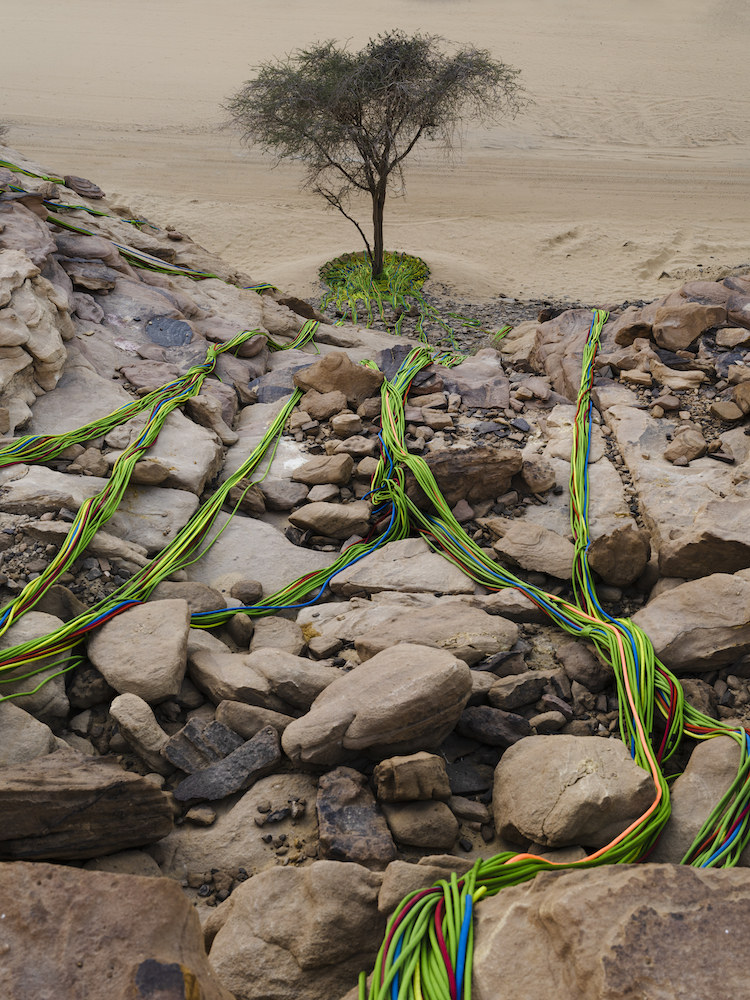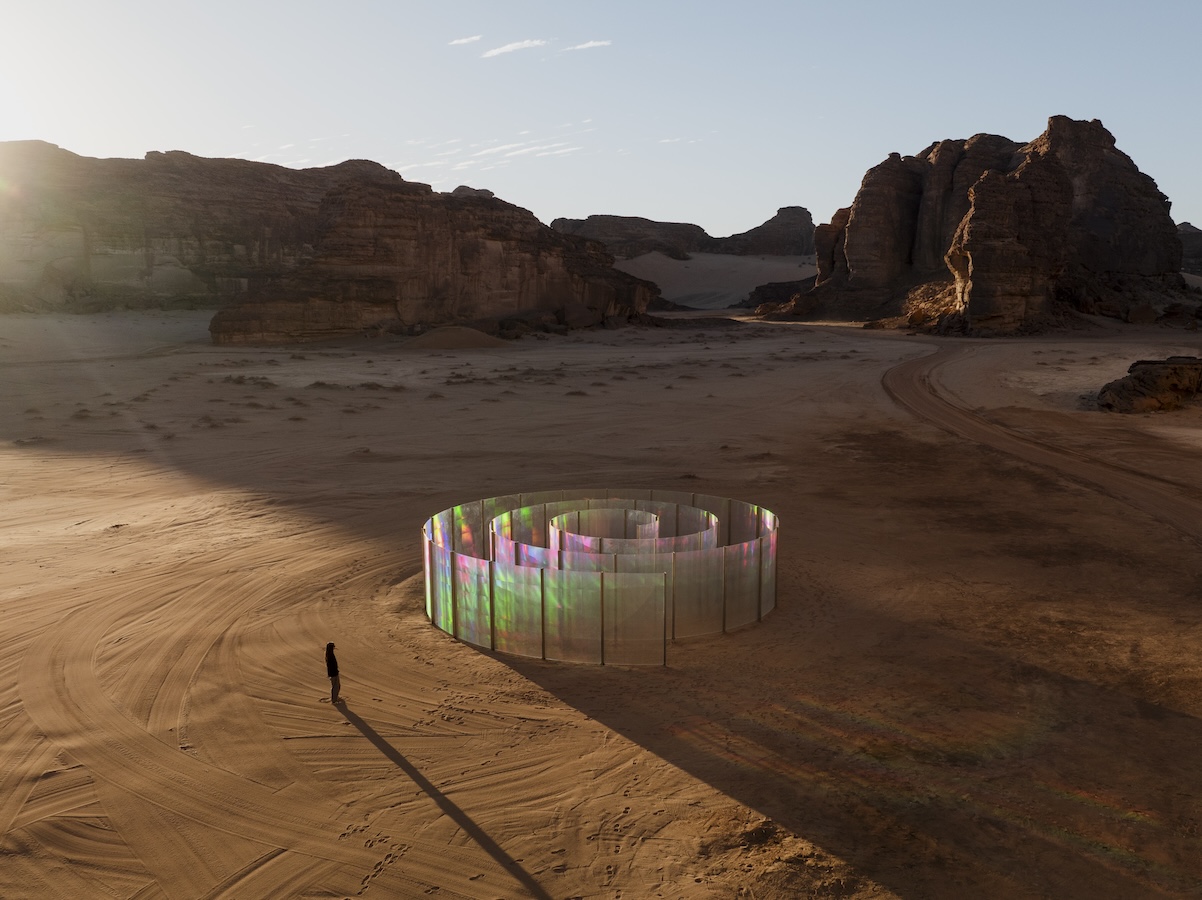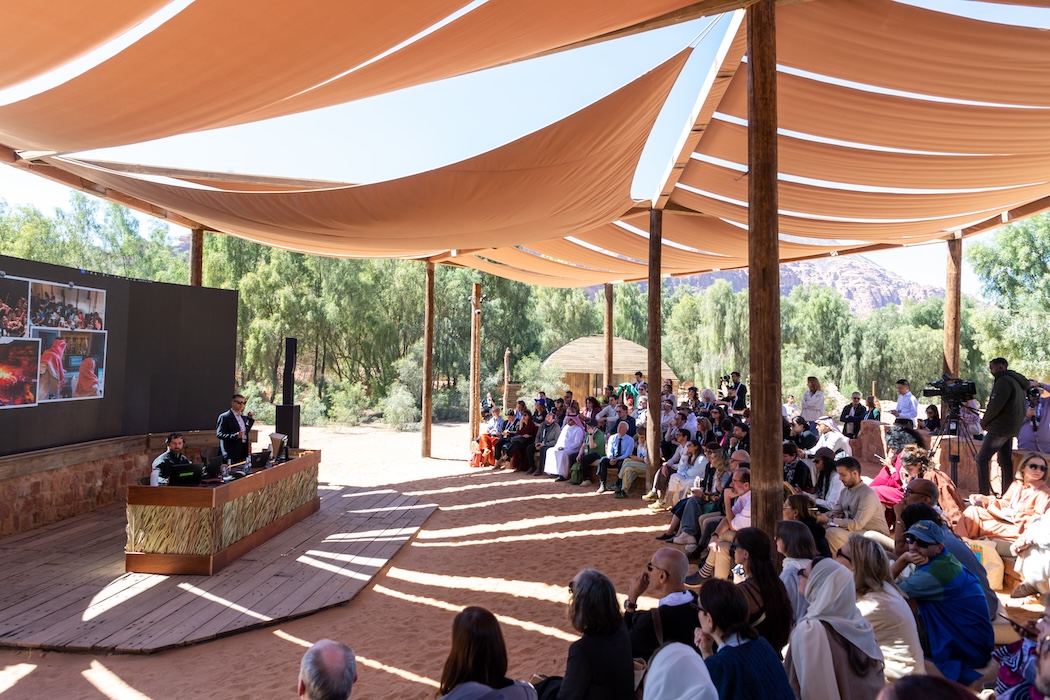Saudi Arabian artist Ayman Zedani’s soundscape installation, The Valley of the Desert Keepers, is currently on view, part of the second edition of Desert X AlUla. The interactive and dreamlike project consists of an abundance of primary-colored wires spun across a rock-ribbed cavern and culminating in a “tree of life.” Microphones and stereos invite visitors to experience a pre-recorded audio projection of music and voices, mythically amplified throughout the endless desert landscape.
Zedani’s immersive artworks begin with and end with question — deeply considering the past and the future of the Gulf. The artist finds points of connection between the human and non-human worlds, and brings to light the unexpected harmony in nature’s will to survive. His creative explorations are both factual and fictional, scientific and whimsical, unveiling that the key to ongoing life on earth is collaboration on all fronts.
The site-specific public work at Desert X AlUla is up through the end of March. Whitewall was sat down with Zedani at the opening to hear more about his very personal approach to fusing art, science, and sound in the ancient desert.
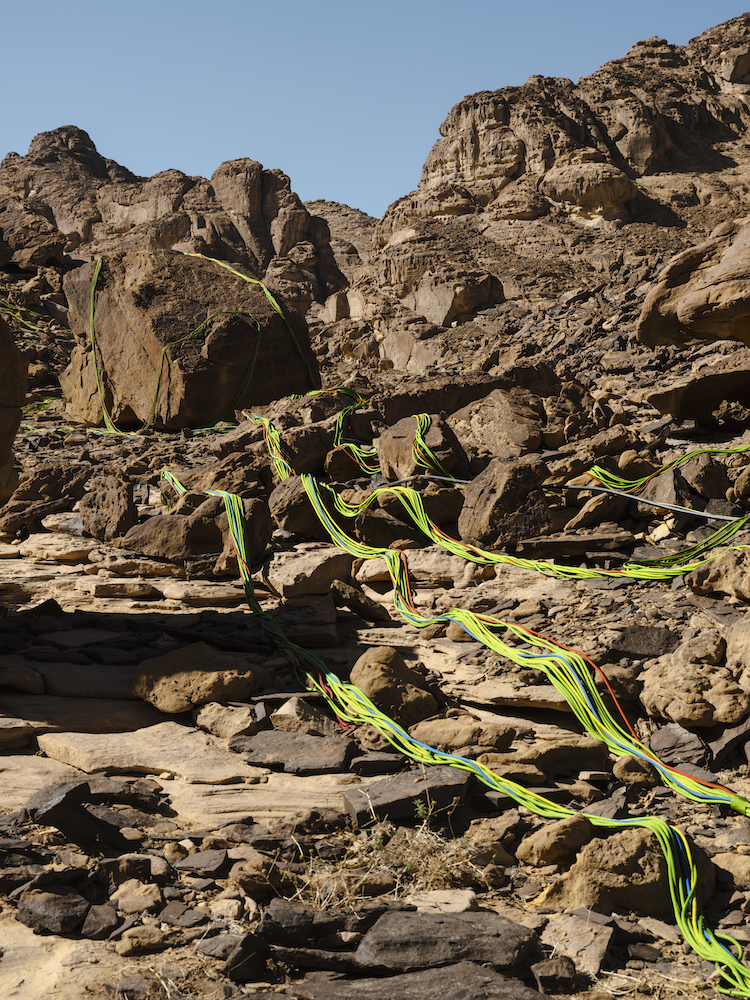
Ayman Zedani, “The Valley of The Desert Keepers,” Desert X AlUla 2022; photo by Lance Gerber, courtesy of the artist and Desert X AlUla.
WHITEWALL: Can you tell us about you as an artist and about your vision for the project?
AYMAN ZEDANI: My practice usually goes between an investigative journey of the human and the non-human in relation to the future of the planet — and more specifically the future of the Gulf. Within my practice I usually take a non-human protagonist, whether that is an animal, plant, or material, and make that the center of the project. I then build a narrative about these protagonists in relation to their environment.
This project, called The Valley of the Desert Keepers, is part of ongoing research that I have been doing for the past couple years in relation to parasitic plants of the desert. I found them really interesting because they rely on something called horizontal gene transfer in which they acquire genes from their host plants to ensure the survival of the offspring. Because this is an ongoing process, they have accumulated a lot of DNA from different desert plants which makes them like a library, an archival, or desert keepers in a sense.
WW: How did your visit visit to the location impact what you wanted to do?
AZ: As we walked into the site I realized that the site is very active. It is full of ringing rocks — when you step on them, they make a sound. I was really fascinated to approach the project in a sonic way whether it’s the rock or even the acacia tree at the exit of the work. These become the influencers in which the projects started to evolve around.
The project has two different audio setups: one of them is to amplify the sound of what is happening in the valley, which is people walking on site or even birds: [the latter] use the concave areas inside these stones to call for each other due to the vastness of the desert. The other setup is an A channel sound of people narrating all the desert plants native to the Gulf region in Arabic. It’s accompanying a lot of different samples that we recorded from the site. You hear the slam of a rock and there is a layer of glass-like sound.
You can’t see the work in its entirety in one position, so you need to walk on site until you arrive at the top which is the most leveled area in the valley. I wanted people to sit and contemplate. When you are in the desert you are faced with the most unforgiving environment to our species. The desert is rich in its own biodiversity and in its own native species, but for us it reminds us of our mortality.
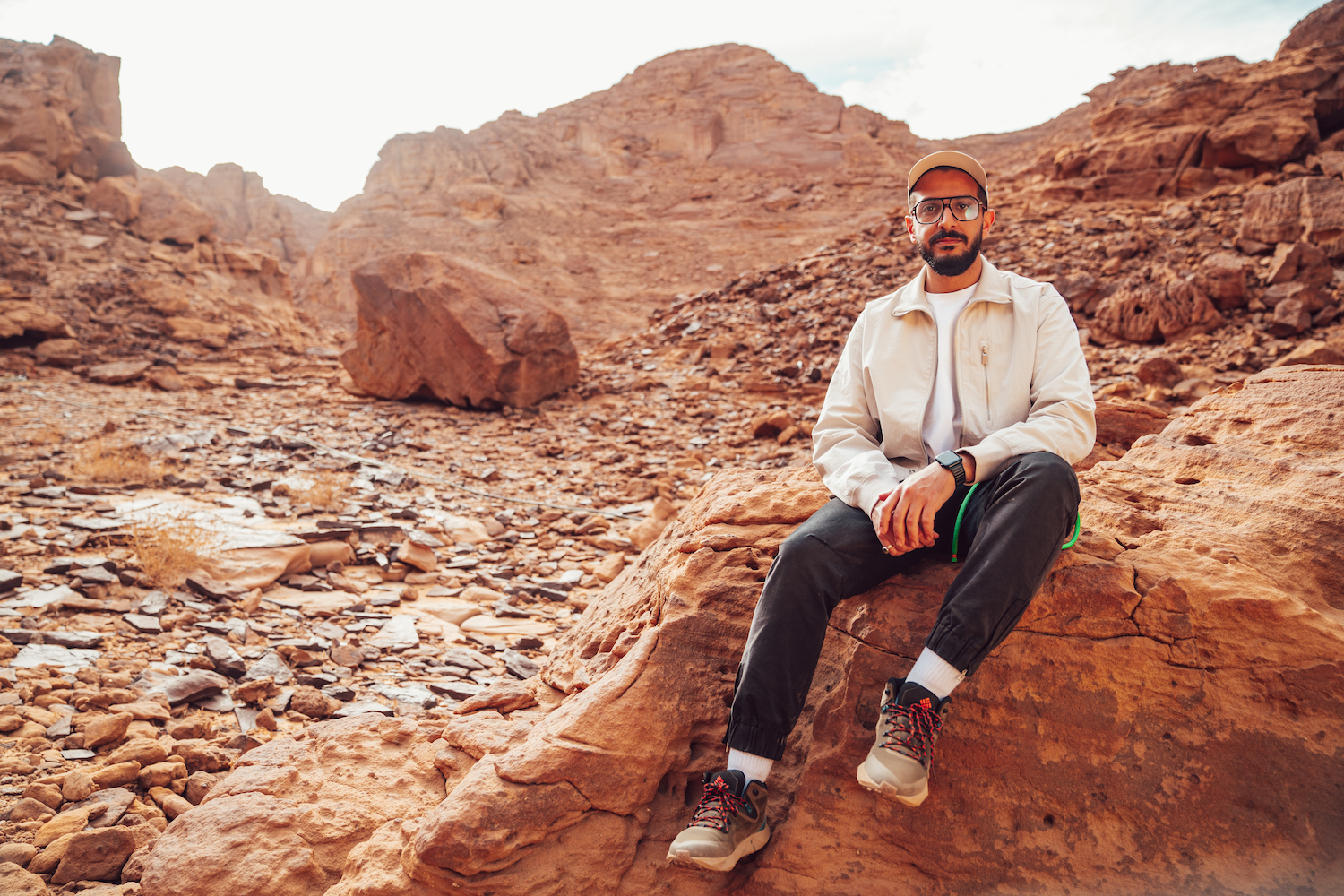
Portrait of Ayman Zedani, courtesy of Desert X AlUla.
WW: How did you become interested in parasitic plants?
AZ: My projects in general are usually informed by scientific research and topics having to do with the environment. I think this is due to my scientific educational background that has still been influenced by my practice as an artist. I’m really interested in this idea of highlighting non-human protagonists and bringing them to the front, to show people that even other life forms have interesting ways of approaching life; maybe we can learn a few things from them about livable futures, especially in relation to the Gulf region.
The life within it has found ways to finesse life which is why I am focused on the parasitic plants. For example, if you look at the acacia tree in the back of my site, there is a branch of another tree that has grown out of the actual acacia tree. The leaves of that branch are different from the main tree. This is how they found ways to assimilate and collaborate. I’m thinking of parasitic plants in this case as not a negative thing. For a long time, people have used parasite or parasitic in a negative connotation, but in this environment, these species have found a way to make life happen.
WW: Can you tell us about your material choice?
AZ: The work was supposed to be only sonic, but then I was struggling with the idea of how do I highlight where people need to walk? They want people to walk between areas where the sound of the rocks could actually be amplified. So we went with something that could represent roots and mimic the connection. There is a lot of wiring for the speakers and the microphones. Using ropes became a perfect sort of synergy with the site.
WW: When we think of the desert we don’t necessarily think of its sound. Why and how did you want to engage the landscape via sound?
AZ: It spoke to me. I came here for a site visit with the notion that I want to make something. I didn’t expect that the space might actually influence the work completely. I’m from the last people who came for the site visit and there weren’t a lot of spaces left. This space doesn’t look aesthetically like any of the other sites in the valley, but as you walk inside of it, it shows you the sonic element; the valley literally is alive. It became very evident I needed to do something sonic, to amplify the site, and I needed to talk about these three elements: the parasitic plants from one end, the walking valley, and the acacia tree in the back.
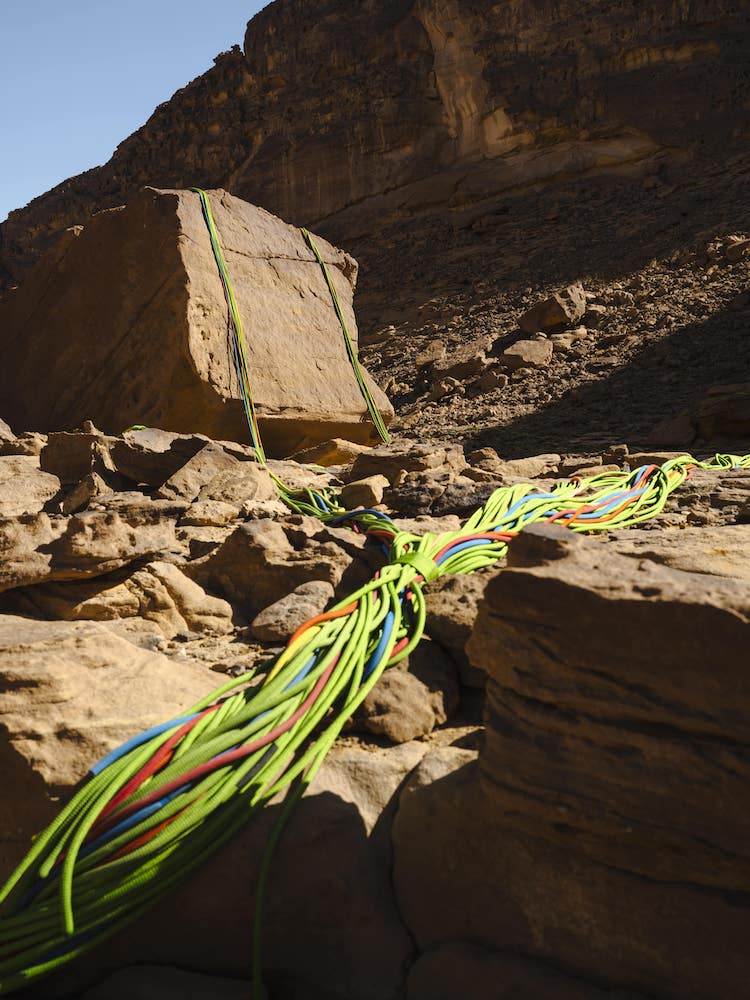
Ayman Zedani, “The Valley of The Desert Keepers,” Desert X AlUla 2022; photo by Lance Gerber, courtesy of the artist and Desert X AlUla.
WW: What kind of soundscape did you want to create?
AZ: It’s a place mimicking a ritual that can echo a lot of the history that has happened here. Different kingdoms have existed in AlUla and I wanted to echo that ongoingness of building, creating, carving, and amplifying.
WW: How did you want the final piece to engage with the landscape?
AZ: I wanted people inside of the valley to get to the highest point. I wanted something that is reactive, that they can feel and play with. I expect that people would be using the mikes at some point to sing into them. I encourage people to do that if they want. I also expect birds to be using the mikes once they realize that it amplifies their sound because they already go to stones and do that naturally. Anything that happens in the valley will be happening all over the place.
WW: Did you explore anything new with the project?
AZ: I got to work directly with nature. I didn’t want to touch the site in any invasive way so I wanted everything to literally sit on top and take the shape of the valley instead of the valley taking the shape of the work.
WW: What aspect of this experience will you take back with you to the studio?
AZ: The sounds. The recordings. I have a couple small stones that I took from the valley to remember that this exists. Even after the work is done, and everything has been removed, the acacia tree will still be there and will be like the marker that something has happened here.
WW: Can you tell us about future projects?
AZ: I am going to continue exploring the parasitic plants. I’ve also done a recent project in relation to the Arabian Sea humpback whale in collaboration with the Environment Society of Oman. I want to focus on bringing the archival material that I’ve gathered through the research process of the past few years into a book that can be published.


